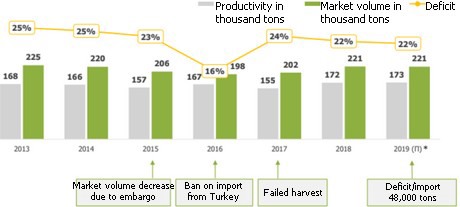The Russian greenhouse industry has seen massive growth recently, with plenty of new projects being realized. With full self-reliance coming ever closer in this market, are there still opportunities to grow? It turns out there are - one of the potential growth markets is indoor cultivation of strawberries. Russian consultancy firm NEO Consult took a closer look at this particular market segment in a new report.
First, some general data regarding the Russian market for year-round strawberry cultivation:
- Market capacity: 220,000 tons
- Internal production: 170,000 tons
- Share of industrial strawberry production: 3%
- Potential strawberry production growth due to announced projects: 6,000 tons
- Strawberry import volume: 50,000 tons
- Potential import replacement (excluding the projects): 20-25,000 tons
- Average yearly selling price: 6.09 euros
- Unoccupied market share: 14,000 tons, which is equivalent to
- 93 ha of greenhouses with a productivity of 15 kg/square meter, or
- 56 ha of greenhouses with a productivity of 25 kg/square meter
According to the report, there are no greenhouses with supplemental lighting for growing strawberries in Russia, mainly fleecing technologies in the open field and plastic foil greenhouses are used.
In the winter period, only imported strawberries are present in the market. All the projects currently in operation are tunnel greenhouses and plastic film greenhouses without lighting (at the moment there are no projects with lighting for year-round cultivation).
Potential for year-round strawberry cultivation
Access to strawberries is limited throughout the year. In autumn, winter and spring, domestic production is almost nonexistent - strawberries are imported then.

Source: Federal State Statistics Service, Federal Customs Service, analysis by NEO Center
90% of strawberries are consumed from March to July. Also, 99.6% of crops are harvested in this period.
Contemporary greenhouse technologies (hydroponics, photoculture) enable year-round strawberry cultivation covering the market demand from autumn to spring, However, no projects related to industrial strawberry cultivation in photoculture have been announced, which creates a potential benefit for new players.
Stable strawberry import
In terms of import, around 50,000 tons of strawberries are imported a year, the majority of which from Belarus.

Source: Federal State Statistics Service, analysis by NEO Center

2018 import per country, in thousand tons. Source: Federal State Statistics Service, analysis by NEO Center
Import replacement and market growth
Regarding the replacement of import volumes, as well as market growth in berry consumption and access to berries in winter, the report draws the following conclusions:
- Year-round greenhouses can partially replace import and create new consumption volume in the period of September to March.
- Turkish berries will be hard to replace in April-June due to low costs and good organoleptic qualities.
- Serbian berries can partly be replaced by Russian ones in case of compatible prices for the imported and locally produced berries.
- In May-June partial replacement of Moldovian, Chinese and Armenian berries is possible.
- The main risk of the import replacement strategy lies within the cancellation of food import embargo and subsequent flow of Greek strawberries in Russia.

Source: Federal State Statistics Service, analysis by NEO Center
Potential for Russian strawberry producers
4.6 thousand tons is the capacity of the biggest strawberry producers. In the coming years, capacity growth by 6 thousand tons is possible due to the completion of the announced projects.

Source: Open data, analysis by NEO Center
High market prices
Actual market prices are significantly higher than ones reported by the Federal State Statistics Service (Rosstat), even during the peak of the open field season, as can be seen in the graph below. The yellow line represents sales prices reported by the X5 Retail Group.

Source: Federal State Statistics Service (Rosstat), sales data by trade chain X5, production statistics in the Crimea, NEO Center analysis
The economics of a strawberry greenhouse
According to the report, the net operational margin of a plastic foil greenhouse project is 35-40%. The production margin for year-round projects involving lighting is higher.

Possible economics of strawberry cultivation in plastic foil greenhouses without lighting. Source: Company data, SPARK, open sources
For more information: NEO Consult
NEO Consult
123242 Russia, Moscow
Novinsky blv., 31
+7 (495) 739-39-77
[email protected]
www.neoconsult.ru
